 Let's Do Audit!
Let's Do Audit! Book contents
- Frontmatter
- Contents
- Acknowledgements
- Introduction
- Lesson 1 An introduction to clinical audit
- Lesson 2 Problem identification
- Lesson 3 Setting standards and establishing criteria
- Lesson 4 Measuring current practice
- Lesson 5 Analysing the data and comparing practice with agreed criteria
- Lesson 6 Implement change and re-audit
- Conclusion – let's do audit!
- References
- Appendix. Worked examples of audits
- Glossary of terms
- Index
Lesson 2 - Problem identification
Published online by Cambridge University Press: 05 July 2014
- Frontmatter
- Contents
- Acknowledgements
- Introduction
- Lesson 1 An introduction to clinical audit
- Lesson 2 Problem identification
- Lesson 3 Setting standards and establishing criteria
- Lesson 4 Measuring current practice
- Lesson 5 Analysing the data and comparing practice with agreed criteria
- Lesson 6 Implement change and re-audit
- Conclusion – let's do audit!
- References
- Appendix. Worked examples of audits
- Glossary of terms
- Index
Summary
When you first start to do audit it can seem difficult to know where to begin. In this chapter we take you through the steps of choosing which problems to audit. As you become more experienced, it is not necessary to think at length about all of these steps: it will quickly become clear which problems should be audited and why.
Every health facility in the world can be improved – there is no such thing as a perfect healthcare system. There will be hundreds or thousands of small (or big) problems in each unit which warrant further investigation through an audit. The trick is choosing which one to start with.
Step 1 – How can we identify problems?
There are many problems which warrant audit. They could be noticed by you or by other health professionals, including students, nurses, midwives, doctors, managerial and clerical staff. They could be noted in handover meetings, ward rounds or staff meetings. Senior staff and supervisors often identify problems easily through the observation of staff and processes over a longer period of time but problems could also be noted by patients or their relatives. They could even be highlighted by the media through newspaper reports or on television. Issues could be raised by the Government as matters of national concern or through the introduction of new guidelines or national initiatives.
- Type
- Chapter
- Information
- Let's Do Audit!A Practical Guide to Improving the Quality of Medical Care through Criterion-Based Audit, pp. 13 - 18Publisher: Cambridge University PressPrint publication year: 2010


